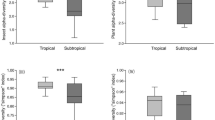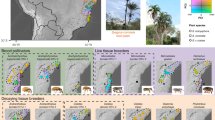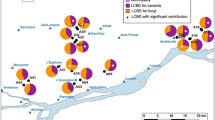Abstract
IN this communication we analyse the insects associated with higher plants other than trees, which have already received attention1–5. We are concerned with two basic problems. First, we ask how various types of higher plants differ in the numbers of species of insects which they support; we do this by comparing standard species–area curves1,3,6,7 for five different sorts of plants. Then we consider how the “taxonomic isolation” of a plant, measured simply as the number of related species in the same genus and geographical region, might also influence the total number of insect species to be found on it. We find that while plant type and geographical range have a considerable effect, taxonomic isolation does not, except in the case of monocotyledonous herbs.
This is a preview of subscription content, access via your institution
Access options
Subscribe to this journal
Receive 51 print issues and online access
$199.00 per year
only $3.90 per issue
Buy this article
- Purchase on Springer Link
- Instant access to full article PDF
Prices may be subject to local taxes which are calculated during checkout
Similar content being viewed by others
References
Opler, P. A., Am. Sci., 62, 67–73 (1974).
Southwood, T. R. E., Symp. R. ent. Soc., 6, 3–30 (1973).
Strong, D. R., Jr, Proc. natn. Acad. Sci. U.S.A., 71, 2766–9 (1974).
Strong, D. R., Jr, Science, 185, 1064–6 (1974).
Van Valen, L., Nature, 253, 684 (1975).
Dritschilo, W., Cornell, H., Nafus, D., and O'Connor, B., Science, 190, 467–9 (1975).
May, R. M., in Ecology and Evolution of Communities (edit. by Cody, M. L., and Diamond, J. M.) (Harvard University Press, Cambridge and London, 1975).
Atlas of the British Flora (edit. by Perring, F. J., and Walters, S. M.) (BSBI, Nelson, London and Edinburgh, 1962).
Janzen, D. H., Am. Nat., 102, 592–5 (1968).
Simberloff, D. S., A. Rev. Ecol. Syst., 5, 161–82 (1974).
Southwood, T. R. E., Proc. 11th int. Cong. Ent., Vienna, 1, 651–4 (1961).
Feeny, P., Rec. Adv. Phytochem., 10 (in the press).
Futuyma, D. J., Am. Nat., 110, 285–92 (1976).
Clapham, A. R., Tutin, T. G., and Warburg, E. F., Flora of the British Isles (Cambridge University Press, 1962).
Zwolfer, H., Verh. Dtsch. Zool. Ges., 67, 394–401 (1975).
Goeden, R. D., and Louda, S. M., A. Rev. Ent., 21, 325–42 (1976).
Cummins, K. W., A. Rev. Ent., 18, 183–206 (1973).
Author information
Authors and Affiliations
Rights and permissions
About this article
Cite this article
LAWTON, J., SCHRODER, D. Effects of plant type, size of geographical range and taxonomic isolation on number of insect species associated with British plants. Nature 265, 137–140 (1977). https://doi.org/10.1038/265137a0
Received:
Accepted:
Published:
Issue Date:
DOI: https://doi.org/10.1038/265137a0
This article is cited by
-
Non-native plants rarely provide suitable habitat for native gall-inducing species
Biodiversity and Conservation (2021)
-
Bracken fern (Pteridium aquilinum (L.) Kuhn) overgrowth on dry Alpine grassland impedes Red List Orthoptera but supports local orthopteran beta diversity
Journal of Insect Conservation (2021)
-
Predicting the outcome of potential novel associations: interactions between the invasive Vincetoxicum rossicum and native western Chrysochus beetles
Biological Invasions (2019)
-
Differences in meristems between monocots and dicots and susceptibility to attack by gall-inducing insects
Arthropod-Plant Interactions (2017)
-
Does time since introduction influence enemy release of an invasive weed?
Oecologia (2013)
Comments
By submitting a comment you agree to abide by our Terms and Community Guidelines. If you find something abusive or that does not comply with our terms or guidelines please flag it as inappropriate.



